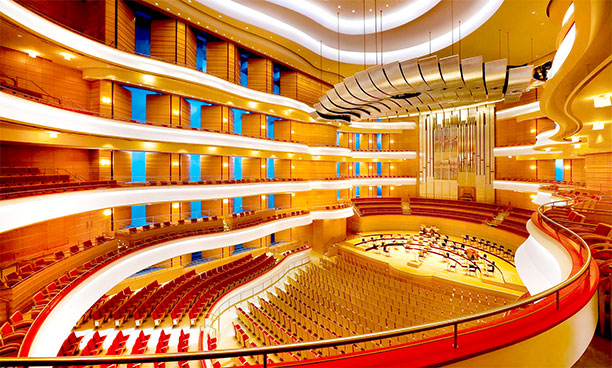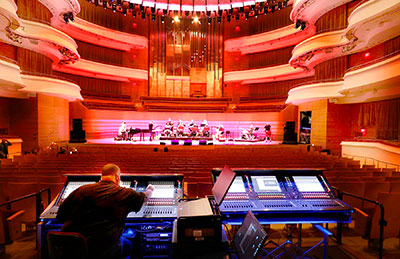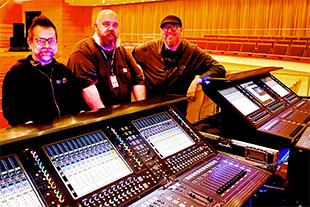
The Segerstrom Center for the Arts in Costa Mesa, California, has completed an upgrade of Segerstrom Hall, a 2,994-seat opera house-style theatre and the largest at the venue, as a venue for Broadway musicals, ballet and other large-scale productions.
The 14-acre campus complex also boasts the 1,704-seat Renée and Henry Segerstrom Concert Hall and the 375-seat Samueli Theater – a multi-purpose facility, for jazz, cabaret, theatre and special events – as well as the 53,000sq-ft Orange County Museum of Art. Among the many organisations call Segerstrom ‘home,’ include the South Coast Repertory and three resident performance companies – the Pacific Symphony, the Philharmonic Society of Orange County, and the Pacific Chorale.
 The Segerstrom Center is also home to six DiGiCo mixing consoles, including a Quantum2 38Pulse that is brought into the audience space for shows that require an in-house mix position, while a second Quantum3. Segerstrom Hall similarly has a Quantum3. John Downey, Head Audio Engineer at the Renée and Henry Segerstrom Concert Hall, jokes that their previous suite of consoles were verging on antiques: ‘We take very good care of them, but it was time,’ he says, ‘Those consoles weren’t being supported anymore.’
The Segerstrom Center is also home to six DiGiCo mixing consoles, including a Quantum2 38Pulse that is brought into the audience space for shows that require an in-house mix position, while a second Quantum3. Segerstrom Hall similarly has a Quantum3. John Downey, Head Audio Engineer at the Renée and Henry Segerstrom Concert Hall, jokes that their previous suite of consoles were verging on antiques: ‘We take very good care of them, but it was time,’ he says, ‘Those consoles weren’t being supported anymore.’
The search for the next round of desks focused quickly on DiGiCo. ‘It was the brand and the quality product that everybody wanted, so it was a real easy decision,’ Downey says, noting the frequency with which DiGiCo – and increasingly Quantum – appear on the contract riders he deals with.
As importantly, the consistency of the Quantum operating system across all of the campus venues means his own staff – A1 Timothy K Schmidt at the Samueli Theater, and Phil Harris on monitors, plus James Wilcox, Head Audio Engineer at Segerstrom Hall – can comfortably move between all of the venues as needed.
 ‘The ability to use a single surface that operates the same in all the spaces enables our engineers to be able to go from room to room and do what they need to do without any substantial learning curve,’ he confirms. ‘To that end, everything we bought were nearly identical systems. All seven SD-Racks are identical and they can roll from space to space as needed. They’re all on HMA fibre and configured similarly.’
‘The ability to use a single surface that operates the same in all the spaces enables our engineers to be able to go from room to room and do what they need to do without any substantial learning curve,’ he confirms. ‘To that end, everything we bought were nearly identical systems. All seven SD-Racks are identical and they can roll from space to space as needed. They’re all on HMA fibre and configured similarly.’
That consistency also helps the staff with the wide variety of performance types hosted in these multiple venues, which can run from pop and classical music to Broadway shows to educational presentations. ‘Whether we need one channel or an entire console – or even two consoles for a show – everything is on the Optocore loop, as are the SD-Racks that drive my processors,’ Downey says. ‘That allows me to load a file without having to massively reconfigure things to accommodate whichever “flavour” we’re doing at the time.’
Chris LeBer, President of Apex Audio, had pointed that capability out to Downey a year ago when the updating process was just starting: ‘It’s a big complex of stages and venues, and they do a lot of different types of shows, so the connectivity between the consoles and their ease of learning and use was big factor in this choice,’ he says. ‘The way Quantum is laid out and the Optocore integration make it as though it was one console for the campus.’
But, of course, it’s not, and those consoles will get moved around the campus often. That, says LeBer, is where DiGiCo’s pedigree as a touring desk comes into play. ‘They’re rugged, tour-proven consoles,’ he says. ‘It’s a big campus with a lot of stages, but for a DiGiCo, that kind of moving around is a piece of cake. Wherever they go, the workflow is the same. DiGiCo wasn’t just the right choice – it was really the only choice.’











